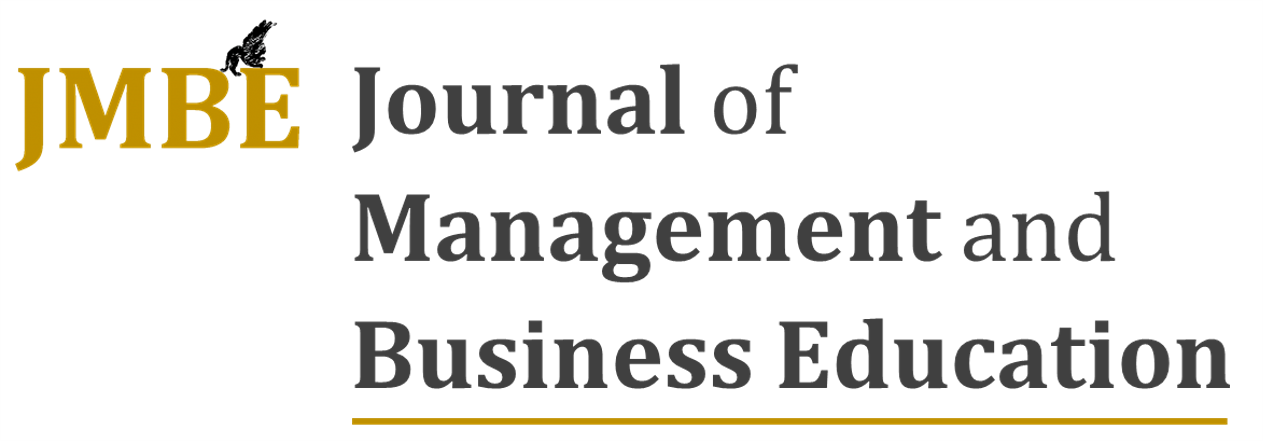The influence of green shared vision, education and training, and green recruitment, on organizational citizenship behavior for environment in elementary schools in Indonesia.
DOI:
https://doi.org/10.35564/jmbe.2023.0018Keywords:
Education, Training, Green Recruitment, Green Shared Vision, Organizational Citizenship Behavior, EnvironmentAbstract
Managing human resources in schools as a basis for instilling knowledge becomes a strategic phenomenon. The importance of these human resources needs to start with a sustainable development plan, with green regulations and a green environment. Analysis of the influence of Green Shared Vision, Education and Training and Green Recruitment on Organizational Citizenship Behavior for the Environment is the main objective of this research. To achieve the research objectives, the object of this study were all elementary school employees, Yogyakarta Province - Indonesia, with a sample calculation using the slovin method of 163 workers in the school. Retrieval of data using purposive random sampling method and cluster sampling technique. With 23 indicators of 4 variables measured by simantec scale. The analysis tools used are validity and reliability, using Variance Based Structural Equation Modeling (SEM) analysis, with the SmartPLS version 4 software tool. The research results show that Green Shared Vision has no effect on Organizational Citizenship Behavior for Environment, Education and Training, Green Recruitment has a positive and significant effect on Organizational Citizenship Behavior for Environment.
Downloads
References
Ahmed, U., AlZgool, M. R. H., & Shah, S. M. M. (2019). The Impact of Green Human Resource Practices On Environmental Sustainability. Polish Journal of Management Studies, 20(1), 9–18. https://doi.org/10.17512/pjms.2019.20.1.01 DOI: https://doi.org/10.17512/pjms.2019.20.1.01
Bass, B. M. (1990). From transactional to transformational leadership: Learning to share the vision. Organizational Dynamics, 18(3), 19–31. https://doi.org/10.1016/0090-2616(90)90061-S DOI: https://doi.org/10.1016/0090-2616(90)90061-S
Bentler, P. M., & Bonett, D. G. (1980). Significance tests and goodness of fit in the analysis of covariance structures. Psychological Bulletin, 88(3), 588–606. https://doi.org/10.1037/0033-2909.88.3.588 DOI: https://doi.org/10.1037/0033-2909.88.3.588
Chang, T.-W. (2020). Corporate Sustainable Development Strategy: Effect of Green Shared Vision on Organization Members’ Behavior. International Journal of Environmental Research and Public Health, 17(7), 2446. https://doi.org/10.3390/ijerph17072446 DOI: https://doi.org/10.3390/ijerph17072446
Chang, T.-W., Chen, F.-F., Luan, H.-D., & Chen, Y.-S. (2019). Effect of Green Organizational Identity, Green Shared Vision, and Organizational Citizenship Behavior for the Environment on Green Product Development Performance. Sustainability, 11(3), 617. https://doi.org/10.3390/su11030617 DOI: https://doi.org/10.3390/su11030617
Chen, Y.-S., Chang, C.-H., Yeh, S.-L., & Cheng, H.-I. (2014). Green shared vision and green creativity: The mediation roles of green mindfulness and green self-efficacy. Quality & Quantity, 49(3), 1169–1184. https://doi.org/10.1007/s11135-014-0041-8 DOI: https://doi.org/10.1007/s11135-014-0041-8
Chin, W. W. (1998). Commentary: Issues and Opinion on Structural Equation Modeling. Management Information Systems Research Center, 22(1), vii–xvi.
Díez-Martín, F., Miotto, G., & Del-Castillo-Feito, C. (2023). The intellectual structure of gender equality research in the business economics literature. Review of Managerial Science. https://doi.org/10.1007/s11846-023-00671-8 DOI: https://doi.org/10.1007/s11846-023-00671-8
Dwi Lestari, E., Rizkalla, N., & Purnamaningsih, P. (2022). The Effect of Perceived University Support, Entrepreneurial Self-Efficacy And Proactive Personality In Promoting Student Entrepreneurial Intention In Indonesia. Journal of Management and Business Education, 5(2), 169–197. https://doi.org/10.35564/jmbe.2022.0011 DOI: https://doi.org/10.35564/jmbe.2022.0011
Fornell, C., & Larcker, D. F. (1981). Structural equation models with unobservable variables and measurement error: Algebra and statistics.
https://doi.org/10.2307/3150980 DOI: https://doi.org/10.2307/3150980
Giordan, J. C. (1995). One Point of View: ‘That Vision Thing’ is the Key to Sustainable Competitive Advantage. Research-Technology Management, 38, 8–22. https://doi.org/10.1080/08956308.1995.11674285 DOI: https://doi.org/10.1080/08956308.1995.11674285
Guerci, M., Montanari, F., Scapolan, A., & Epifanio, A. (2016). Green and nongreen recruitment practices for attracting job applicants: Exploring independent and interactive effects. The International Journal of Human Resource Management, 27(2), 129–150. https://doi.org/10.1080/09585192.2015.1062040 DOI: https://doi.org/10.1080/09585192.2015.1062040
Gurmani, J. K., Khan, N. U., Khalique, M., Yasir, M., Obaid, A., & Sabri, N. A. A. (2021). Do Environmental Transformational Leadership Predicts Organizational Citizenship Behavior towards Environment in Hospitality Industry: Using Structural Equation Modelling Approach. Sustainability, 13(10), 5594. https://doi.org/10.3390/su13105594 DOI: https://doi.org/10.3390/su13105594
Hair, J., Hult, G. T. M., Ringle, C., & Sarstedt, M. (2014). A Primer on Partial Least Squares Structural Equation Modeling (8th ed., Vol. 2). SAGE Publications, Inc. https://doi.org/10.54055/ejtr.v6i2.134 DOI: https://doi.org/10.54055/ejtr.v6i2.134
Hair, J. T., Hult, G. T. M., Ringle, C. M., & Sarstedt, M. A. (2017). Primer on Partial Least Squares Structural Equation Modeling (PLS-SEM) (Second Edition). Sage. https://doi.org/10.3926/oss.37 DOI: https://doi.org/10.3926/oss.37
Hox, J. J., & Bechger, T. M. (1999). An Introduction to Structural Equation Modeling. Family Science Review, 11, 354–373.
Janse, J. J. P., George, G., Bosch, F. A. J. V. den, & Volberda, H. W. (2008). Senior Team Attributes and Organizational Ambidexterity: The Moderating Role of Transformational Leadership. Journals of Management Studies, 45(5), 982–1007. https://doi.org/10.1111/j.1467-6486.2008.00775.x DOI: https://doi.org/10.1111/j.1467-6486.2008.00775.x
Khan, N. U., Wu, W., Saufi, R. B. A., Sabri, N. A. A., & Shah, A. A. (2021). Antecedents of Sustainable Performance in Manufacturing Organizations: A Structural Equation Modeling Approach. Sustainability, 13(2), 897. https://doi.org/10.3390/su13020897 DOI: https://doi.org/10.3390/su13020897
Larwood, L., Falbe, C. M., Kriger, M. P., & Miesing, P. (1995). Larwood, L.; Falbe, C.M.; Kriger, M.P.; Miesing, P. Structure and meaning of organizational vision. Acad. Manag. J. 1995, 38, 740–769. Academy of Management, 38, 740–769. https://doi.org/10.2307/256744 DOI: https://doi.org/10.5465/256744
Liu, L., & Zhao, L. (2019). The Influence of Ethical Leadership and Green Organizational Identity on Employees’ Green Innovation Behavior: The Moderating Effect of Strategic Flexibility. IOP Conference Series: Earth and Environmental Science, 237, 052012.
https://doi.org/10.1088/1755-1315/237/5/052012 DOI: https://doi.org/10.1088/1755-1315/237/5/052012
Malik, S. Y., Hayat Mughal, Y., Azam, T., Cao, Y., Wan, Z., Zhu, H., & Thurasamy, R. (2021). Corporate Social Responsibility, Green Human Resources Management, and Sustainable Performance: Is Organizational Citizenship Behavior towards Environment the Missing Link? Sustainability, 13(3), 1044. https://doi.org/10.3390/su13031044 DOI: https://doi.org/10.3390/su13031044
Mandip, G. (2012). Green HRM –People Management Commitment to Environmental Sustainability. Research Journal of Recent Sciences, 1, 244–252. https://doi.org/10.2139/ssrn.3323800 Result score too low DOI: https://doi.org/10.2139/ssrn.3323800
Mirza, M., Konadi, W., & Mukhlis, M. (2022). Effect Of Education and Training, Career Development And Position Placement On Performance Of Employees Almuslim University Bireuen District. indOmera, 1(1). https://doi.org/10.55178/idm.v1i1.208 DOI: https://doi.org/10.55178/idm.v1i1.208
Mishra, P. (2017). Green human resource management: A framework for sustainable organizational development in an emerging economy. International Journal of Organizational Analysis, 25(5), 762–788. https://doi.org/10.1108/IJOA-11-2016-1079 DOI: https://doi.org/10.1108/IJOA-11-2016-1079
Mozammel, S. (2019). Understanding Post-Training Factors and Job Performance Relationship: Review of Literature for Transfer of Training Enthusiasts. Annals of Contemporary Developments in Management & HR, 1(3), 33–38. https://doi.org/10.33166/ACDMHR.2019.03.004 DOI: https://doi.org/10.33166/ACDMHR.2019.03.004
Paillé, P., Chen, Y., Boiral, O., & Jin, J. (2014). The Impact of Human Resource Management on Environmental Performance: An Employee-Level Study. Journal of Business Ethics, 121(3), 451–466. https://doi.org/10.1007/s10551-013-1732-0 DOI: https://doi.org/10.1007/s10551-013-1732-0
Pham, N. T., Phan, Q. P. T., Tučková, Z., Vo, N., & Nguyen, L. H. L. (2018). Enhancing the organizational citizenship behavior for the environment: The roles of green training and organizational culture. Management & Marketing, 13(4), 1174–1189. https://doi.org/10.2478/mmcks-2018-0030 DOI: https://doi.org/10.2478/mmcks-2018-0030
Pinzone, M., Guerci, M., Lettieri, E., & Huisingh, D. (2019). Effects of ‘green’ training on pro-environmental behaviors and job satisfaction: Evidence from the Italian healthcare sector. Journal of Cleaner Production, 226, 221–232. https://doi.org/10.1016/j.jclepro.2019.04.048 DOI: https://doi.org/10.1016/j.jclepro.2019.04.048
Rice, M. P., O’Connor, G. C., Peters, L. S., & Morone, J. G. (1998). Managing Discontinuous Innovation. Research-Technology Management, 41, 52–58. https://doi.org/10.1080/08956308.1998.11671210 DOI: https://doi.org/10.1080/08956308.1998.11671210
Sarstedt, M., Ringle, C. M., & Hair, J. F. (2014). PLS-SEM: Looking back and moving forward. Long Range Planning, 47(3), 132–137.
https://doi.org/10.1016/j.lrp.2014.02.008 DOI: https://doi.org/10.1016/j.lrp.2014.02.008
Satu Data Pendidikan Kabupaten Sleman. (2023). https://datapendidikan.slemankab.go.id/
Sulisworo, D., & Maryani, I. (2017). Identification of teachers’ problems in Indonesia of Facing Global Community. International of Journal of Research Studies in Education, 6(2), 81–90. https://doi.org/10.5861/ijrse.2016.1519 DOI: https://doi.org/10.5861/ijrse.2016.1519
Sundararajan, M. (2021). Exploration Of Personal Ethics: An In-Class Case Exercise for Business Ethics Students To Help Them Develop Personal Values. Journal of Management and Business Education, 4(2), 116–135. https://doi.org/10.35564/jmbe.2021.0007 DOI: https://doi.org/10.35564/jmbe.2021.0007
Tang, G., Chen, Y., Jiang, Y., Paillé, P., & Jia, J. (2018). Green human resource management practices: Scale development and validity. Asia Pacific Journal of Human Resources, 56(1), 31–55. https://doi.org/10.1111/1744-7941.12147 DOI: https://doi.org/10.1111/1744-7941.12147
Urbancová, H., Stachová, K., & Stacho, Z. (2015). Methods of Recruitment in the Czech and Slovak Organizations. Acta Universitatis Agriculturae et Silviculturae Mendelianae Brunensis, 63(3), 1051–1060. https://doi.org/10.11118/actaun201563031051 DOI: https://doi.org/10.11118/actaun201563031051
Vogus, T. J., & Sutcliffe, K. M. (2012). Organizational Mindfulness and Mindful Organizing: A Reconciliation and Path Forward. Academy of Management Learning & Education, 11(4), 722–735. https://doi.org/10.5465/amle.2011.0002c DOI: https://doi.org/10.5465/amle.2011.0002c
Walker, H. J., Feild, H. S., Giles, W. F., Bernerth, J. B., & Short, J. C. (2011). So, what do you think of the organization? A contextual priming explanation for recruitment Web site characteristics as antecedents of job seekers’ organizational image perceptions. Organizational Behavior and Human Decision Processes, 114(2), 165–178. https://doi.org/10.1016/j.obhdp.2010.11.004 DOI: https://doi.org/10.1016/j.obhdp.2010.11.004
Willness, C., & Jones, D. A. (2013). Corporate environmental sustainability and employee recruitment: Leveraging “green” business practices to attract talent. Routledge Academic. https://doi.org/10.4324/9780203142936-25 DOI: https://doi.org/10.4324/9780203142936-25
Yamjal, P., & AL-Sa’di, A. (2022). Strategies For Retention and Completion In Vocational Education: Faculty Perspectives. Journal of Management and Business Education, 5(4), 247–265. https://doi.org/10.35564/jmbe.2022.0015 DOI: https://doi.org/10.35564/jmbe.2022.0015
Zhang, Y., Luo, Y., Zhang, X., & Zhao, J. (2019). How Green Human Resource Management Can Promote Green Employee Behavior in China: A Technology Acceptance Model Perspective. Sustainability, 11(19), 5408. https://doi.org/10.3390/su11195408 DOI: https://doi.org/10.3390/su11195408
Downloads
Published
How to Cite
Issue
Section
License
Copyright (c) 2023 Journal of Management and Business Education

This work is licensed under a Creative Commons Attribution-NonCommercial-ShareAlike 4.0 International License.
License terms at: https://creativecommons.org/licenses/by-nc/4.0/legalcode




